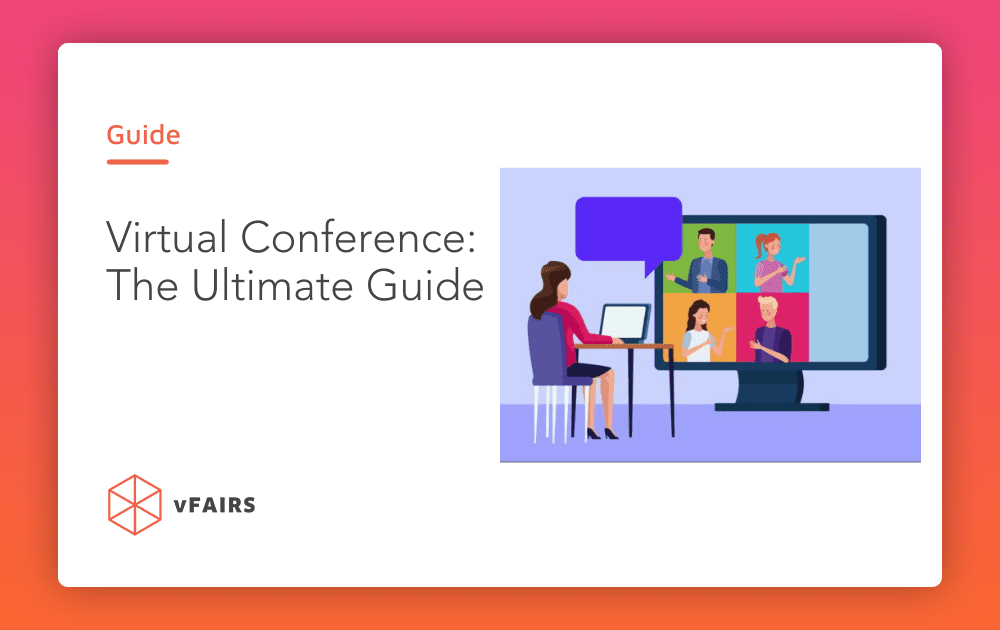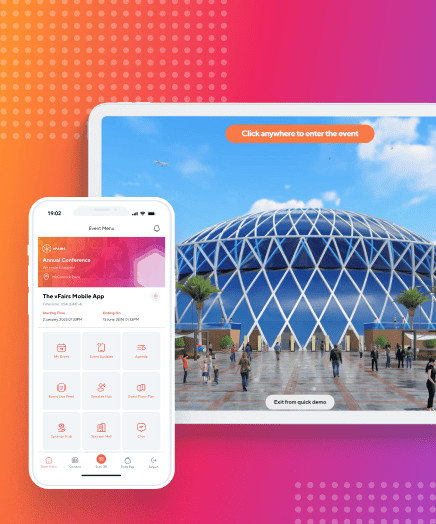A virtual conference offers a platform for event organizers and marketers to connect globally and share knowledge while saving bucks. The convenience of attending a conference from the comfort of your home is unmatched.
77.2% of event organizers believe that virtual conferences are popular because of the ease of attendance. No travel time, no expensive tickets and no jet lag.
That’s what online technology brought to us. If you are an event company, or an organization planning a virtual conference, this guide is for you.
What Is a Virtual Conference?
A conference is generally a gathering of like-minded individuals. They discuss a theme or matter of common interest. It brings together a large group of people who share common niche interests or expertise to discuss, network, learn, and plan the next steps. A conference usually has formal speaker sessions, panel discussions, Q&As, and presentations around a specified theme.
Virtual events have the same goals and areas of focus, the only difference is that it is hosted through a virtual conference platform. It can include keynote sessions, breakout sessions, and much more to interact and engage with audiences – all happening virtually.
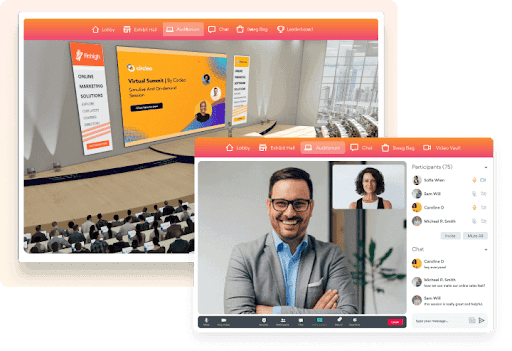
7 Quick Steps to Host a Virtual Conference
Even though virtual conferences have been present for quite some time, there is still a lot that you can improve when it comes to planning and execution. If done correctly, virtual conferences can be even more powerful than any traditional in-person conference.
Here is a step-by-step guide on how to host a virtual conference.
Step 1: Define the Goal of Your Virtual Conference
What do you want to achieve when you host a virtual conference? What business objectives will your conference help you attain? Who is your target audience? Which speakers would fit the topic of your conference? What metrics will you measure to gauge the success of your event? Is this conference largely for idea sharing? Networking? What else?
Answering these questions can help you and your team construct a clear picture of your goals. It directs them to take the relevant actions to get to the finish line. Once your goals are defined you will be able to utilize various virtual platform features better.
Step 2: Choose a Reliable Virtual Conference Platform
The choice of conference hosting platforms is greatly dependent on the sort of tools and amenities you require for your event. Essentially, the goal of every virtual conference is to allow the participants to interact and network with people. Networking is mostly where the audience draws value from.
Make sure to choose the best virtual conference platform that offers multiple engagement tools, such as gamification and live chat. Not just that, you need to ensure that the technical equipment you’ve acquired will support seamless operations, and if need be, a proactive technical support team is always on standby during the event.
Step 3: Identify the Best Tools for Engagement
Once you have defined your objectives and goals for the event you will be able to ascertain what kind of features to use. Does your conference offer some training? You can accredit certifications for attendees who complete a training module you’ve set up.
You can even create a virtual photo booth for your attendees to take pictures that can be shared on the photo wall.
Do you want to engage attendees over social media and promote your event through hashtags? For that, you can use the social media wall. At vFairs, your dedicated project manager will assist you in identifying all the features that will support your event goal.
Tips on How to Make a Virtual Conference Engaging
Here are some quick virtual conference tips that you can incorporate to make your online conference engaging:
- Use live polls, Q&A sessions, and live chat to encourage attendees to actively contribute and share insights.
- Create immersive 3D environments with personalized avatars for exhibitors and attendees to enjoy.
- Infuse fun gamification elements such as a virtual scavenger hunt, leaderboards, and trivia games for a lively atmosphere.
- Offer diverse content formats such as webinars, panel discussions, and workshops, to break the monotony.
- Use LinkedIn community builder to allow attendees to connect outside the online conference.
- Allow participants to personalize their agendas based on which webinars they are interested in attending.

Step 4: Invite Relevant Sponsors and Exhibitors
You will need exhibitors and sponsors to increase the ROI of your event as a revenue stream or invite them as a speaker at your conference. Your sponsors will take up promotional spaces in your event and get visibility. So, it’s important to onboard them and sign the contracts.
With an intuitive backend portal, they will be able to manage their booth and data without any hassle for you and your team.
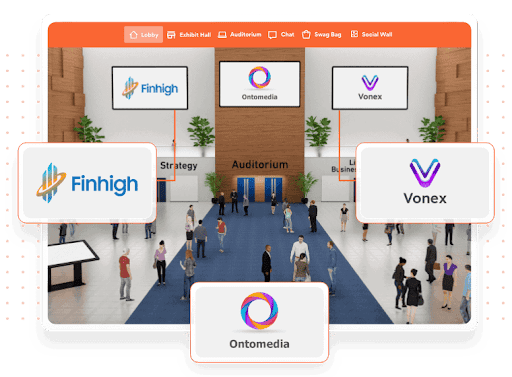
Step 5: Find Speakers
The real catch for your audience is the speakers. Make sure you arrange speakers that your audience can relate with. Find ones who are experts in the industry for credibility. You will also need a decent moderator. They will also be responsible for making the webinars interactive through polls, Q&As, etc.
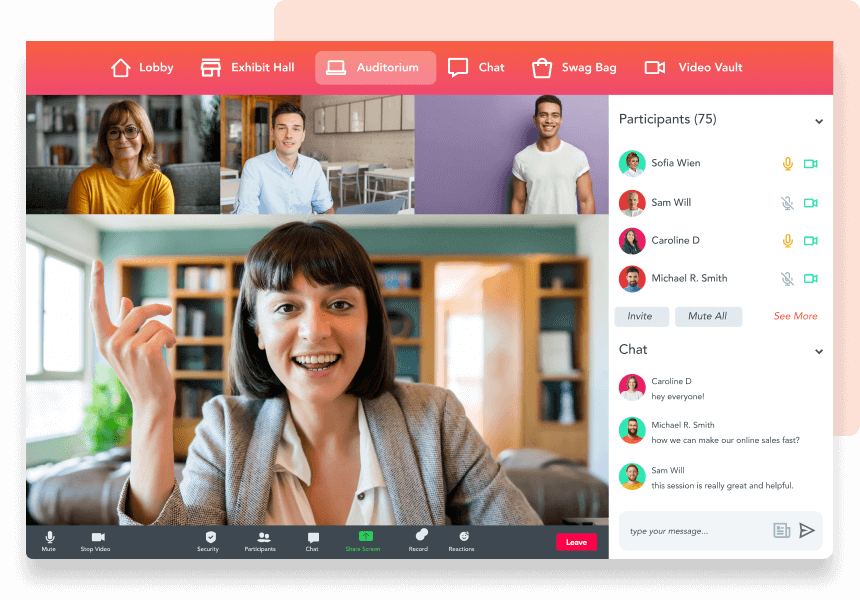
Step 6: Promote Your Virtual Conference
To achieve your attendance goals, you need to drive more registrations. At this point, your promotional efforts will play a key role in making or breaking your event. Some of the obvious channels to promote your event are:
- Social media – Once you have researched your target audience you will know which platform will work best for them. Choose Facebook, Twitter, LinkedIn, Reddit, or any other platform based on your findings.
- Email marketing – Make use of your existing mailing lists and share newsletters and conference details to attract new registrations.
- Speakers’ social media – Ask your panelists to promote the conference on their networks as well.
- Company employees – Ask your employees to share within their networks and social media.
- Other websites – Go for paid promotions on other websites and pages such as a banner, pop-up, or snack bar about the event.
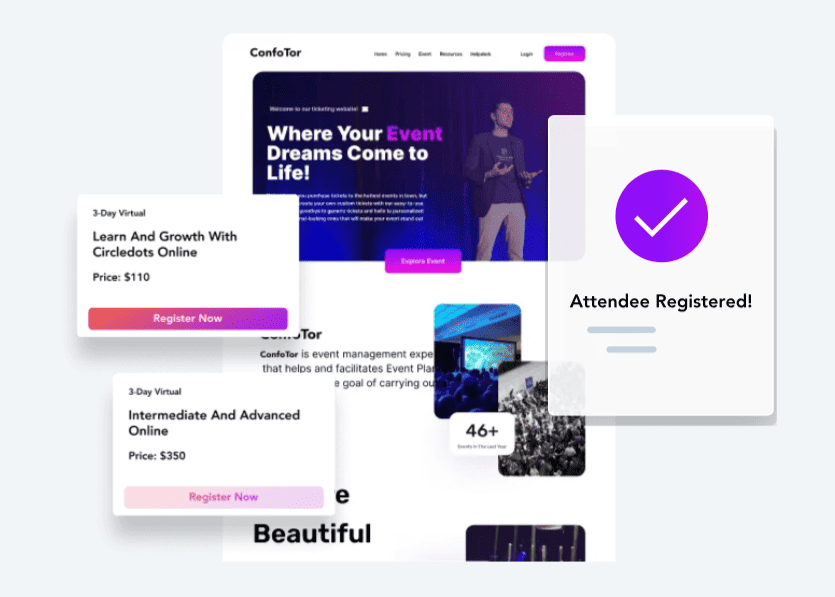
Step 7: Do a Practice Run
Before the day of the event, and once you have it all set up, do a dry run of the entire event with your virtual conference platform. Make sure it is operating seamlessly and cater to any last-moment glitches in the virtual conference technology.
Virtual Conference KPIs to Measure Success
Virtual conferences are an effective way to network and communicate with groups and individuals belonging to a certain niche. They contribute to lead generation and business growth at the same time, just as any other physical conference.
What’s different is that you can now obtain definite results, set measurable virtual event KPIs, and justify your ROI.
We have compiled a set of key virtual conference metrics that can help you determine your online event’s success:
- Total number of registrations – While attendance is important, registrations can be just as useful. You can use the contact information that registrants submit to set up a database for marketing your business in the future.
- Number of attendees – Once you have the total number of registrants, you would like to know how many of them attended the event. The conversion rate will help you determine the effectiveness of your marketing efforts.
- Document downloads – At a conference, people are looking for information. The number of resources they consume will help you understand what value you offer with the resources. This information, as opposed to an in-person conference, assists in measuring your audience’s engagement.
- Video views – Streamable videos attract great traction from audiences. Total video views per booth help in determining the exact impact of the visuals.
- Chat usage – What makes any event a great success, especially conferences, is the engagement rate. With booths equipped with audio, video, and chat capabilities, interactions help understand how hooked the audience is.
- Attendees per webinar – Measuring participation per webinar helps understand the audience’s needs and interests to better prepare for future conferences and summits, topics of discussion, and live Q&A sessions.
Pro Tip: Measure Using an AI Reporting Chatbot
vFairs offers features such as an AI Reporting Chatbot that can help you get all the event information with quick prompts. All you need to do is choose your report form, ask a question about that report, and hit send. The chatbot will give you particular data about your event that you can download as well.
The Benefits of a Virtual Conference
The lack of physical interaction does not necessarily have to rip the benefits of hosting an online conference. Hosting a virtual conference doesn’t mean you compromise on any of the core benefits. Often, it can surpass the value yielded by its physical counterparts.
1. Easy Access and Increased Attendance
A virtual conference eliminates the need to travel to a physical venue to be present at the event. At the same time, it also prevents jet lag and other travel-related stress. Traveling to your chosen physical venue can sometimes be difficult. Thus, some attendees choose not to show up at all. Hosting virtually can change that as it is much easier to access the event online.
One of the most popular benefits of hosting a virtual conference is access from any device. Attendees can log in from any browser or an event mobile app. Hosting a virtual event of this nature lets you reach a wider audience. Attendees can also create their own virtual conference agendas before the event. They have the flexibility of planning their day around relevant sessions.
2. More Value at Reduced Cost
With a virtual conference, you can cut back on some major costs and improve positive ROI for your event. You get the convenience of hosting online, reduced costs, and more revenue streams as well.
Moreover, you can say goodbye to venue, accommodation, parking, and catering costs. Additionally, you can invite speakers to present virtually at a fraction of the price as well. As they don’t require traveling and lodging, you save up on those costs and they might even charge you less because they have to spend less time.
3. Networking Done Right
Physical conferences provide greater networking opportunities and allow in person conversations to flow naturally. And nothing beats a physical interaction. Yet, how many times have you tracked down and met the right point of contact ‘naturally’? How much of your time is wasted looking for the right ‘network’?
Virtual conferences make networking easy. With text, video, and audio chat participants can form lasting ties effectively. New features such as matchmaking tools, now save time and match you based on your profiles.
Virtual roundtables allow attendees to efficiently discuss certain topics in small groups. There are networking lounges where attendees can move around and take advantage of the spatial connect feature to network with fellow attendees.
4. Measurable Results
We’ve already talked about the event metrics you should be measuring to gauge success at your virtual conference above.
Switching to a virtual conference can lead to this data being more accurate and helpful as online event platforms can measure live and post-event data for you. Organizers can choose to track data with real-time reports and multiple dashboards and can make live data-driven changes to the event. It can help plan and organize groundbreaking events in the future as well.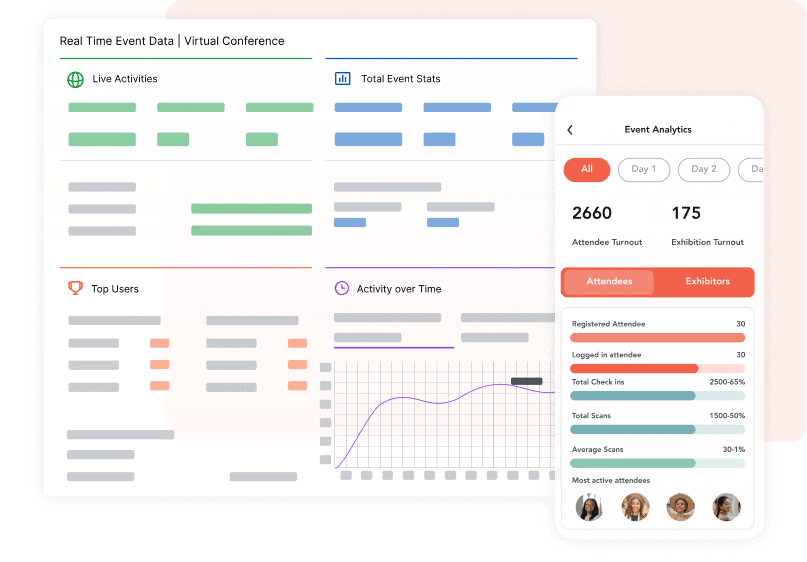
5. Decreased Carbon Footprint
Aviation contributes about 2% of the world’s global carbon emissions. Traveling to a conference can increase carbon emissions and virtual events are a way to stop that from happening. Electricity needed to power an event venue also contributes to GHG emissions. Waste produced by printed materials, catering, and vehicular travel also increases the carbon footprint of the event. This has huge environmental implications. Recordings from a virtual conference and other documents can be used on demand for years to come.
Sustainability in events is no longer just a buzz word and the events industry is exploring more ways to reduce its carbon footprint with innovative new ways.
6. Quick Feedback
Live webinars at virtual conferences are usually followed by interactive Q&A sessions. In these sessions, organizers invite suggestions and recommendations directly from the audience.
This is a more accurate way of understanding your audience’s profiles and concerns. It allows companies to incorporate that feedback into improving their processes.
7. Lead Generation
Registrants who sign up from across the globe can be added to the company’s CRM, mailing lists, and other software for lead generation in the future.
vFairs offers features such as attendee search and filter and contact exchange functions whereby attendees can start generating leads within the virtual event.
8. Industry Trends & Insights at Your Fingertips
Virtual conferences bring top trends and insights right to your doorstep. Make the most out of webinars, live chats, and much more. You can now grow your knowledge base in only a few clicks. While sipping away your choice of caffeinated beverage.
9. Encouraging Diversity and Equity
Virtual conferences are open to all kinds of people in all parts of the world, provided they can connect to the internet. This makes the audience more diverse and your business more global.
What’s more, you can include various accessibility features that can loop in a wider audience. This includes audio and visual support, closed captions, color adjustments, and multilingual features.
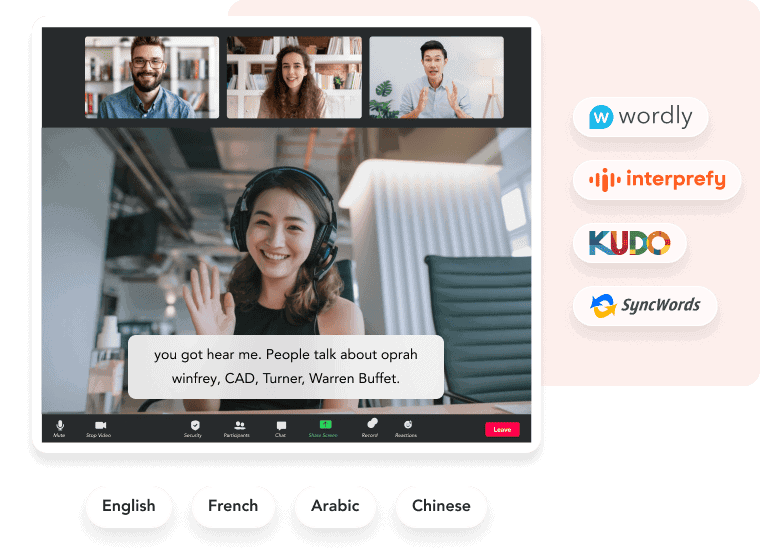
10. On-Demand Availability
Your virtual event can be available on demand even after the live dates end. This ensures those in other time zones can access the event at easier times even if they miss the live presentations.
You can make all shared resources, webinars, presentations, and other collateral available on demand. This guarantees the largest global reach and participation.
10 Must-Haves for a Virtual Conference
1. Customization or Configuration Options
You may want to use a conference platform that suits your needs and offers customization. For example, if you’re a travel agency, you can create a fully immersive vacation-inspired venue. If you’re a corporate organization, you can replicate your head office layout in your virtual venue. Moreover, you can pick and choose from the features that you want to add to your conference according to your event goals.
Platforms such as vFairs help you create an entirely customized experience. With all the features that best suit your virtual conference. For instance, at a virtual job fair, you have access to features such as a job board and resume portals. To host webinars you can use the integrations you are most familiar with whether Zoom, MS Teams, or others.
A networking lounge, a keynote session, or a sponsored meeting can also provide an opportunity for the attendees to be involved in event dialogue through different participation formats.
2. User Friendliness
Platforms like vFairs that are intuitive and easy to use are important to host virtual conferences. If you want to save time, make sure the site you’re using can offer automation for event setup, marketing, and post-event analysis. This comes in handy when you want to organize virtual events in a short time. You can ask sales reps from virtual event platforms you’re considering the following questions to inquire about automation:
- Can I get a tour of your backend?
- Will I need training to make use of your backend?
- How long will that take?
- How long does it take for your platform to reflect the changes on the front end?
- Can the exhibitors/organizers make changes on the backend or do they have to involve your team in everything?
3. Live Broadcasting and Pre-Recorded Video Hosting
A virtual conference will be incomplete if it doesn’t let the organizers and participants interact live. You should look for sites that support a multitude of slideshows and presentations from different speakers. The platform should have live webinar hosting and streaming capabilities so you can share your live video through multiple platforms. It could be a Restream link, a Zoom broadcast, or even live feeds on social media.
If you want to save time, pre-recorded content is also a great option. You can also ensure that the recorded lectures are accessible at all times through registration.
4. Networking Features
It is essential to facilitate networking at a virtual conference and you can do that with a platform offering robust networking capabilities. Look for conference hosting platforms that seamlessly integrate live chat features. This real-time communication tool facilitates instant interactions between participants, speakers, and organizers.
The virtual networking lounges with spatial networking options also let attendees move around in a space and connect with people around. Features like vFairs smart matchmaking are also proven to be helpful in connecting people with similar backgrounds and interests for collaboration and engagement.
Topic-based roundtables also offer a space for attendees to come together for collaborative problem-solving and discussion. Attendees can also schedule 1:1 meetings with the meeting scheduler tool with exhibitors and fellow attendees.
5. Event Marketing
A crucial part of hosting successful virtual conferences is event promotion. You may want your lecture or online auction to reach as many people as possible. Plan the meeting with the help of your team and use Search Engine Optimization (SEO) tools such as tags, titles, and keywords.
You can use Facebook, Twitter, and Instagram to promote your workshop or lecture. Attendees can share quotes, and screenshots, or react to your online performance. For this purpose, try to find a platform that integrate with social media outlets or supports the promotion of your event on social media.
The AI-powered vFairs Webinar Summary and Chapterization tool allows hosts and organizers to generate quick marketing content. It creates blogs, summaries, webinar chapters, social media posts, and newsletters to repurpose your conference content. You can even create email campaigns using the vFairs AI tool to share with your list.
6. Sponsorship
Sponsors can fund your digital gatherings, making them more credible. They can also promote your work, so you may want to treat them as collaborators.
Engaging your audience is also essential. Sponsors can help you set up a giveaway or a virtual after-party. For example, they may include a celebrity that can add value to your virtual meeting. Remember to choose an interactive platform that allows sponsorships and brand deals. You can create event sponsorship packages and dedicate spaces within your mobile event app for them.
7. Abstract Management and Poster Hall
With abstract management software, you can collect papers, and enable single and double-blinded peer reviews. For academic virtual conferences, this feature can be really helpful.
It allows review management with automated emails to reviewers with a login link. Once reviewers accept or reject abstracts, authors get an email notification as well. All the selected papers get published at your virtual conference through a poster hall, live presentations, or resource documents. So, you can finish the entire process from collecting abstract submissions to showcasing the approved research at your event with one single platform.
The virtual poster hall allows you to display research posters and link them to pre-recorded poster presentations. Attendees can download the PDF version of those posters and get printed handouts as well.
8. Troubleshooting and Customer Support
With virtual events, we also worry about internet connection problems. Sign-in difficulties, and other issues that may disrupt the online conference. Hence, troubleshooting should be a priority if you’re organizing a virtual event.
vFairs offers video conference services with adequate 24/7 customer support. This includes an info desk at the virtual event for attendees.
9. Reports and Insights
One of the features that sets a virtual conference apart from a physical conference is reporting. A virtual conference allows organizers to gain valuable information about the attendees like how they interacted with the different features offered in the online conference.
Before selecting a platform for a virtual conference, do not forget to inquire about reporting. Not every platform shares data which means you have to talk about it before signing a deal.
The vFairs Reporting Chatbot provides answers to all reporting questions. All you need to do is ask the bot in simple language, for example, the number of attendees in a certain webinar, and it will give you a number. This way you don’t have to go and look into reports, but simply ask the AI-powered bot.
Using these event insights, you can understand which webinars and features were popular and engaged the most and use this data for future online conferences.
10. Feedback and Growth
To understand the user experience, you can set up surveys for your audience. That way, you can understand what your viewers want to see more of or what they don’t like. For example, you can schedule your meeting based on a poll about the date or specific topic. You can also create surveys for your sponsors on any topic that they might want insights on from the audience.
Questions to Ask Your Virtual Conference Provider
Conferences are set up to bring together like-minded groups of people to share their knowledge about a similar topic of interest or talk about industry trends. What makes this possible and successful are the tools used to drive engagement and derive value from the conversations and interactions at the event.
Hence, your virtual event provider needs to keep in mind the goal of your virtual conference. So they can equip you with all the necessary tools required to pull off an outstanding event.
Before you get started, here’s a set of questions you might want to inquire about.
1. Will I Get a Detailed Demo of My Virtual Conference?
Request a thorough demo of the platform to get a sense of what your virtual conference will look like. The demo will also help you test aspects like platform functionality, ease of use, navigation, visual quality, and built-in features that are central to obtaining your event objectives.
Getting the look and feel of your future online conference is crucial. A custom demo is your first step to visualizing and planning a virtual conference.
Pro tip: If you’re looking for a low-touch option, many platforms like vFairs will offer a self-guided tour. These allow you to experience the platform for yourself and assess whether it would suit your needs before you get on a call with a company representative.
2. Are There Any Past Events That Can be Shared?
You want to choose a solution provider that has worked with a diverse range of top organizations. Executed a wide range of virtual conferences, and can provide you with customization that best matches your event. Look for customer success stories to determine if they have the numbers to prove themselves.
vFairs has had the experience of setting up events for organizations, corporations, and universities of all sizes. It is the highest-rated virtual events platform on G2 and Capterra. We know exactly how to guide our clients and innovate to meet their targeted KPIs.
3. How Long Does It Take to Set Up?
Do enquire about the average time it takes for the provider to set it up. From start to finish. This will assist you in chalking out your entire pre-event marketing strategy. And will also give your team enough time to prepare for the live event. The ideal time for a high-caliber provider should not cross 4-6 weeks to set up your virtual conference.
vFairs virtual conference platform comes with 24/7 customer support with a dedicated project manager to help you set up the event. If you are a bit tech savvy, vFairs also provides free training so the clients can set up their own events with ease. The intuitive backend allows anyone to make changes and manage their event easily.
4. Where Will the Virtual Conference be Hosted and Is It Secure?
Make it a point to ask your virtual events provider about the virtual conference hosting company that they partner with, and the specific security features that they have in place. This is necessary as your online conference should be secure from data fraud, viruses, and crashing servers when the event sees bulk registration.
5. Is the Platform Compatible Across Devices and Operating Systems?
While your visitors will be accessing your online conference using smart devices, you need to make sure you provide them with a seamless experience on their smartphones, laptops as well as tablets. In addition, ensure that your vendor provides event hosting compatible with Android and iOS platforms. After all, you do not want to lose visitor acquisition or engagement due to poor technology compatibility.
6. Who Owns All the Data?
The data stored on your virtual event platform will often be highly confidential. Make sure your contract clearly states the provider’s right to store and process the data whilst relinquishing all data ownership to your organization.
7. What Kind of Support Do You Offer?
You want to be sure that the solutions provider is not choosing a one-size-fits-all solution for you. It should deliver customized instructions across all phases from booth design, event layout, and marketing. A team dedicated to providing you with end-to-end support will prove most important. This ensures that you won’t have to manage the event in its entirety.
vFairs assigns dedicated project managers to all its clients as a key point of expertise so that all concerns are promptly addressed and objectives met.
8. What Engagement & Interactive Features are Available?
You want to be able to attract, excite, and engage the visitors to leave the intended impact. This plays a huge role in the success of your virtual conference.
Depending on the kind of virtual conference, discuss with your team if you want textual, voice, or video chat-based functionality. Perhaps you want individuals to partake in webinars through a virtual whiteboard. Maybe you need multilingual features to reach an audience that does not speak the native language of your event.
Be specific with how you choose to engage with your visitors so that your virtual conference is one to be remembered.
9. What Sort of Accessibility Options are Available for Differently-abled Visitors?
One of the key points of a virtual conference in comparison to its physical counterparts is that it is accessible and inclusive. It invites quality individuals to participate based on their skills and relevance instead of restricting them based on their unique needs. Look for features such as:
- Color contrast for visually impaired individuals
- Text size adjustment
- Page narration
- Webinars with closed captions and translations
- Clear and straightforward layout for easy navigation
If you wish to reach the globe and offer value to people from around the comfort of their homes, it is imperative to offer a diverse and equitable platform.
Look for accessibility features in your next virtual events provider or talk to our representative to understand more about delivering all that a virtual event truly needs to comprise.
10. What Type of Reports Will Be Generated?
The vendor of your choice should also provide reports that measure the impact of your initiative on your audience. These reports should help determine your KPIs in advance, for example, unique visitors or visits per booth.
Measuring success is pivotal to determining the ROI. Discuss with the vendors how they can help you monitor visitors, downloads, video plays, chats, conversions, etc. before you choose to go ahead with them.
Generate in-depth reports and use the analytics to shape future events.
Defining Your Virtual Conference Content Strategy
To set up a successful event, whether virtual or in-person, you need to put a strong content strategy in place. This includes the design, creation, and management of engaging content across your landing page, social media platforms, e-newsletters, and everywhere else your target audience resides.
A strong content strategy is vital to inspiring, informing, and raising awareness about your event and your brand.
1. Determine Your Event Type and Ideal Client Profile
Who is your target audience? What is it looking for? What are your company objectives, and do you require a meeting, online conference, or a summit to fulfill those?
Streamline your goals and you users’ needs to bring them in line with your content efforts. Simply put – everything you do related to the content should resonate with those predetermined conditions.
2. Plan the Visual Experience
Landing Page
For the event vendor to set up the virtual conference homepage, and start searching for design inspiration (your vendor should be able to share ideas and templates). Brainstorm content for:
- Short, catchy event title
- Logistics – Event date, timings, and time zone
- Content such as what to expect, value props, virtual conference agenda, logos, FAQs, introductory videos, and more
- Cover image and high-resolution logo for the event
- Attendee registration & ticketing form
You can create content for a custom landing page using vFairs AI marketing assistant, which will generate clear and engaging copy with all the details that you provide in minutes.
Internal Venue Design
You can choose to fully customize all aspects of your virtual event venue. Here are a few popular ways vFairs allows you to create a fully-branded experience for your virtual conference:
- Select display – Choose if you’d prefer an animated or static lobby and review available designs/samples from past events. (Our recommendation: An animated lobby delivers a stronger “wow” factor to greet guests).
- Decide lobby banners and logos – e.g. if your exhibitors have paid extra to secure the best logo visibility, their brand promotion should be prioritized over others.
- Discuss customizations – Explore other possible customizations with your virtual career fair vendor such as wall posters and visitor avatars that can be displayed.
- Exhibitor hall design – Similar to the lobby, the “Exhibitor Hall” in a virtual conference is configurable to cater to your content preferences including: a) hall background image b) booth floor layout c) static staff avatars.
- Auditorium design – Gear up to explore auditorium design alternatives so you can add your logo/logos or customize virtual posters as needed.
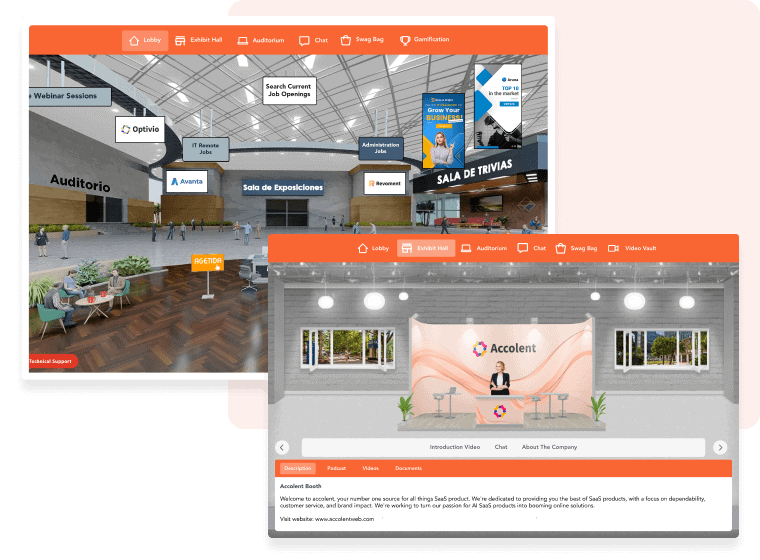
3. Plan Out a Virtual Conference Agenda
Creating a virtual conference schedule that accommodates the calendars of your audience and speakers is key to your conference’s success.
Your landing page should ideally consist of a clear virtual conference schedule of your webinars, the topics of discussion, and the speakers appearing – for those who wish to hop in during the hours of their interest.
Pro tip: You can even get attendees to customize their own virtual conference agendas on the live day(s) so they do not miss out on key sessions.
4. Piece Together the Content for Booths
Now that you’re done setting up a visually impressive, eye-opening, jaw-dropping experience for your attendees, it’s time to add some value for their consumption.
The virtual platform accommodates formats including documents, videos, presentations, picture galleries, live or pre-recorded webinars, and much more. This gives exhibitors a large range of options to deliver and cater to their audiences.
5. Promote Your Event
Use social media platforms, your company website, independent landing pages (such as microsites), and all other mediums to market your event. Attract their attention and provide them with the information necessary for them to understand what your event is about, and eventually compel them to register for it. Make sure you compliment and link every piece of content with a direct CTA.
Want to learn how to promote your event? Check out our Playbook on How To Attract Attendees to Your Virtual Event.
Conclusion
With tons of available resources, a virtual conference can make a big impact. Welcome out of the box virtual conference ideas and turn them into opportunities.
Embrace the virtual landscape without hesitation. Use innovative event technology, create engaging content with AI, and leverage interactive features for virtual conference hosting. From planning to execution, make sure to understand the importance of inclusivity, sustainability, and data-driven decision-making.
Frequently Asked Questions
What is a virtual conference?
A virtual conference or online conference is an event that brings together participants from different locations to engage in presentations, discussions, and networking activities through digital platforms.
How do you host a virtual conference?
To host a virtual conference, you can explore various conference hosting platforms. These platforms provide the virtual conference technology and tools needed to organize, manage, and facilitate virtual conferences. This is how to organize a virtual conference.
Why host a virtual conference?
Hosting a virtual conference provides a global reach, cost-efficiency, and accessibility. Leveraging innovative technology, virtual conferences offer interactive sessions, contribute to environmental sustainability, and provide robust data analytics.
How can virtual conference planning be successful?
Planning a virtual conference successfully involves defining objectives, selecting a suitable virtual conference platform, creating a compelling agenda, and implementing engagement strategies. Consider ideas for virtual conferences to enhance participant experience.
What are some ideas for virtual conference engagement?
Engage participants with virtual conference engagement ideas such as gamified challenges, virtual exhibit spaces, personalized agendas, and post-event resources. Consider innovative ways to foster connections in the virtual environment.
How do you run a virtual conference effectively?
Running an online conference effectively involves following a well-planned online virtual conference schedule, utilizing virtual conference technology for smooth operations, and actively engaging with participants throughout the event. It is important to share the virtual conference agenda with the audience prior to the event.
What are the key components of virtual conference management?
Virtual conference management includes coordinating virtual conference technology, scheduling sessions for the virtual conference agenda, handling registrations, and ensuring smooth execution.

